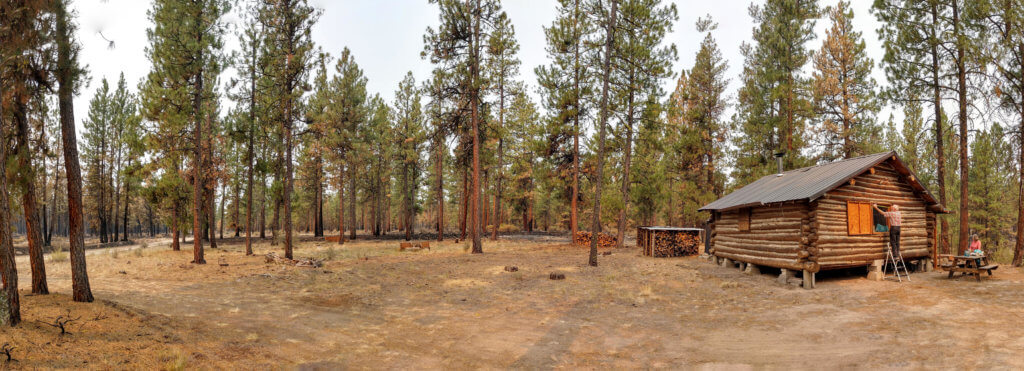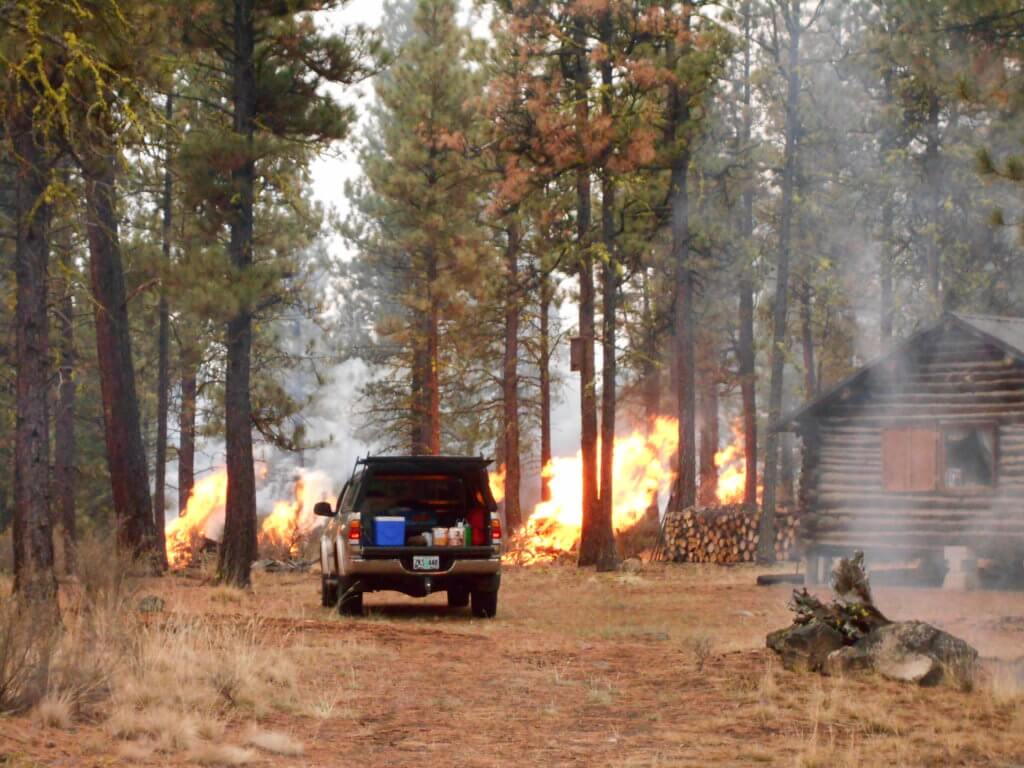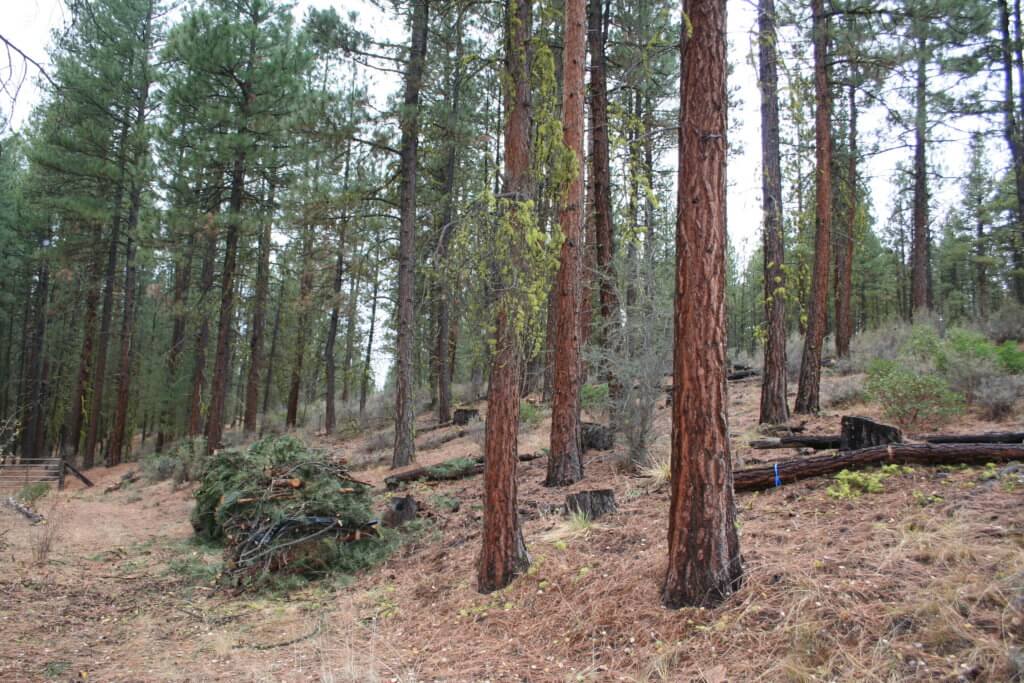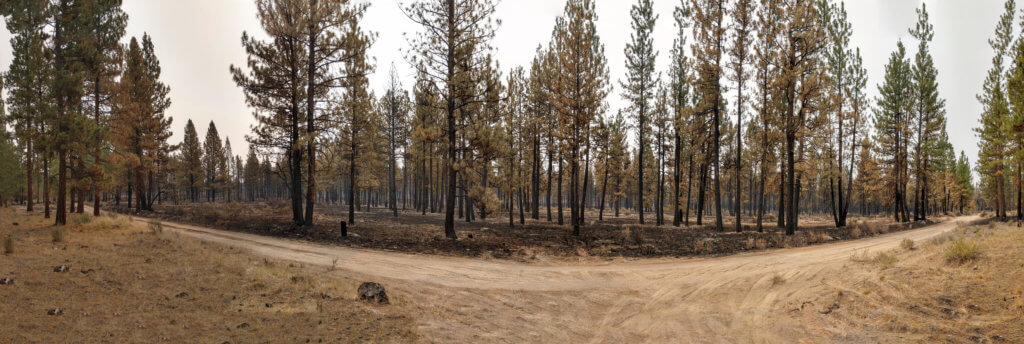PRE-FIRE TREATMENT
STEWARDSHIP PLAN SAVES PROPERTY FROM BOOTLEG FIRE
BY GENE ROGERS

The past two decades of wildland fires have intensified the political and scientific debate about wildfire spread and wildland fuels treatments. Do pre-fire treatments result in changes to the spread and intensity of wildfires? To really answer this question the details of fire behavior – weather, fuels and topography – must be evaluated on a case-by-case basis. The best fuels treatments can be negated by the worst fire-behavior conditions. One fact is clear: under similar conditions, a treated area will survive even moderate fire behavior when a similar area untreated may not.
The South 40, affectionately named by its owners, is a 40-acre parcel of private forest land adjacent to Fremont-Winema National Forest land in southcentral Oregon; the parcel is in a dry Ponderosa pine forest historically prone to fire. The forest property and log cabin survived the Bootleg Fire of 2021. Previous fuels treatments enabled fire suppression personnel to be successful in the point protection of the cabin and adjacent forest stands. This fire burned out of control for nearly two months and for a time was the largest wildfire in the United States in 2021.

The owners purchased the property in 1997. The assorted stumps on the property indicate three or four separate individual tree selection harvests, with the oldest stumps well-rotted. Slash piles are scattered throughout the property from the previous harvests. I confirmed harvest dates back to 1918 in the vicinity.
In 2011, after contact with a local stewardship forester from the Oregon Department of Forestry, the owners became interested in developing a stewardship plan for their property. The stewardship forester explained the process and suggested some local forestry consultants; the owners contacted me and arranged a site visit to discuss objectives and possible mitigation treatments.
The owners explained their plans to make the property and log cabin a legacy for their children and grandchildren; they were interested in forest health, wildlife habitat, excluding free range cattle from the riparian zone on the property, and significantly reducing the potential for high intensity wildfire. I was contracted to develop the plan.
The completed stewardship plan listed:
Goals:
- Improve forest health.
- Restore the riparian area.
- Enhance wildlife habitat.
- Reduce wildland fire hazard.
- Pass this legacy forested property to heirs in better ecological condition than when it was acquired.
Objectives:
- Identify overstocked stands. Implement thinning with fuels treatments to increase vigor for resistance to insects, disease and wildfire.
- Seek assistance with riparian restoration to repair streambed damaged by cattle and prevent future impacts. Identify and protect any artesian flows.
- Improve wildlife habitat by culturing existing, or planting additional trees/shrubs, to increase the carrying capacity and diversity of the property.

In February 2012 the stewardship plan was completed, signed, and approved by the Oregon Department of Forestry. By July 2012 the owners had secured grant and cost-share money for fencing the riparian area and thinning of prioritized areas identified in the plan. In September 2013, the 32 acres of forest on the South 40 had been thinned by a crew from the Klamath Tribes, arranged by the Lomakatsi Restoration Project. Much of the downed wood was donated as firewood and some to small milling operations. Additionally, 30 per cent of the brush from the creek to powerline fence was removed, the remaining brush height was reduced 30 per cent and 30 per cent of the small, fresh brush growth was left. The slash was hand piled. In September 2014 a crew from the Lomakatsi Restoration Project burned more than 100 piles of slash remaining from the thinning operation in 2013.

By 2019, plans were being made for a co-operative prescribed fire project. Local US Fire Service personnel were including the owners in the planning process. The goal was to conduct a prescribed underburn through the forest stands previously thinned on federal and private land; this would be the final step in the fuels-treatment plan. Weather conditions were not favorable in 2020 and the COVID-19 pandemic further complicated options. The spring of 2021 was dry, precluding prescribed fire. In April 2021, the Ponina Fire covered 1,641 acres near the South 40, coming within one-half mile of the property. The spread rate and intensity of this pre-season wildfire foretold the coming summer. On July 6, the Bootleg fire was detected and quickly became the largest current wildfire in the United States. It covered 413,717 acres before containment in late August.
The Bootleg fire crossed the South 40 in the first few days of spread. On July 24, I met the landowners on the property. The owners were anxious to see the fire effects, having previously verified the cabin had been protected. Fire personnel had obviously assisted in the protection of the cabin as evidenced by a hand line constructed around the cabin area.
The thinned stands for the most part appeared to have had light to moderate mortality. Certain areas would have experienced significant mortality in the pre-treatment condition of overstocked trees and high loadings of dead and down wood from beetle kill.

Below the cabin is the riparian area and more thinned pine stands. Some individual trees and small groups of trees did torch out, but the majority of the trees appeared to have had enough canopy to survive.
We agreed that the objectives of the planned prescribed fire had been met by the wildfire firing operations. We are optimistic that additional stocking level control will only increase the vigor and health of the surviving trees. Watching the response of the vegetation in the next few years will be telling. All agreed that the South 40 surviving the Bootleg fire was the result of the stewardship plan developed a decade earlier and the implementation of treatments recommended in the plan.
Following our site visit on July 24, the owners sent me photos taken by a game camera near the cabin. The photos clearly show firefighting resources visiting the property as the Bootleg fire approached. Local US Fire Service personnel were familiar with the property and informed the incident management team of the property location. Incident fire personnel visited the site in advance of the Bootleg fire to begin planning point protection operations.
Overhead and engine personnel arrived at the cabin site and began structure and property triage in preparation for a defensive firing operation. A fireline was constructed with hand tools around the cabin prior to the firing operation.
Wildland engines from the Bureau of Land Management assigned to the Bootleg Fire are seen supporting the firing operation and providing structure protection for the cabin. Time stamps on the images indicated that the operation took several hours.
The BLM engines moved out after the fire behavior diminished. The property was frequently visited by several agency and contract engine crews plus law enforcement personnel through the next two days including a California Office of Emergency Services unit (CA-OES). Personnel from the engines were seen patrolling on foot around the cabin and the fireline. No holding or structure protection challenges were presented.
The firing operation was successful in removing surface fuels prior to the arrival of the Bootleg fire. The fuel reduction work accomplished by the owners played a key role in the protection of their property. An on-site review in October 2021 with the owners and local US Fire Service fire personnel concluded that the firing operation done in advance of the approaching Bootleg fire was a good surrogate for the prescribed fire that had not been able to be implemented.
A spring follow-up site visit and future monitoring will be done to evaluate the apparent success story of The South 40.
ABOUT THE AUTHOR
Gene Rogers is the president and consulting forester for Wildland Fire Technologies, Inc. based in Klamath Falls, Oregon. He served in a variety of fire management positions with the U.S. Forest Service, Bureau of Land Management and the National Park Service. He retired in 2003, in his thirty-fourth fire season. Rogers is a fire behavior analyst, a qualification he has maintained since 1987. He served two terms on the IAWF board of directors, has chaired and co-chaired conferences and served on numerous committees. His bachelor of science degree in natural resources is from Humboldt State University, and he completed forestry graduate work there and at the University of Washington.
